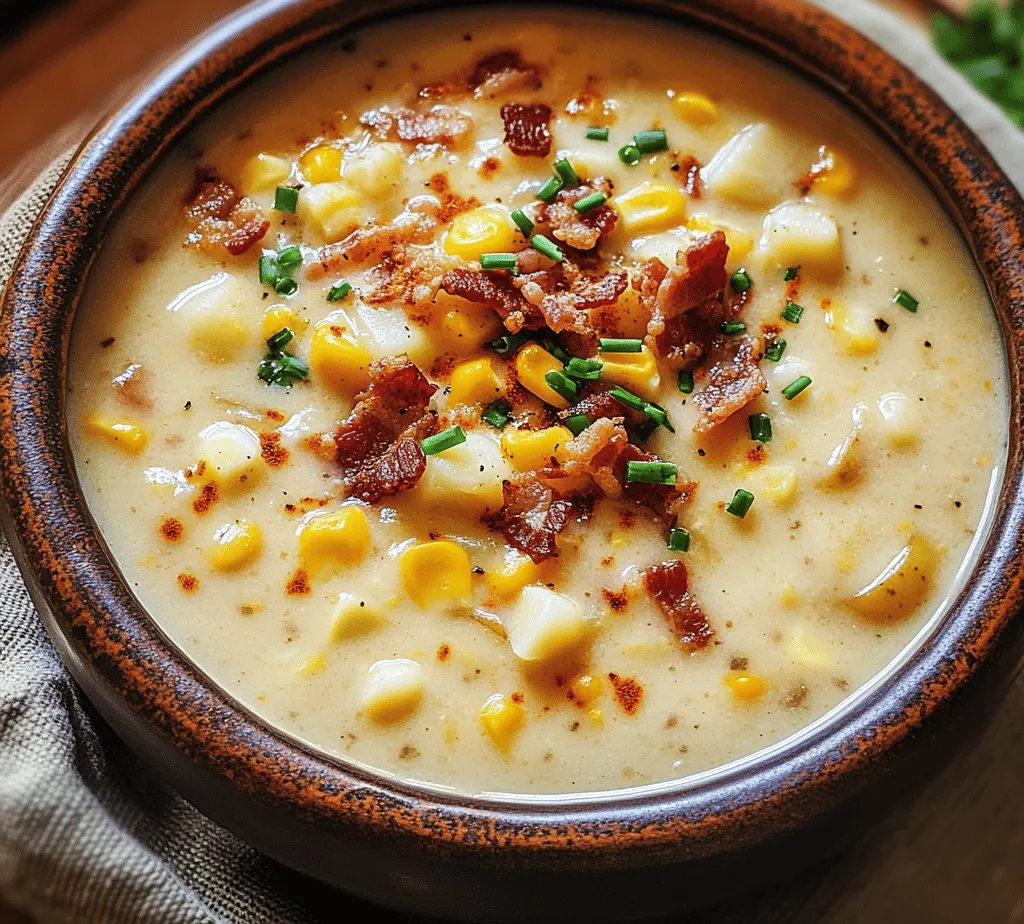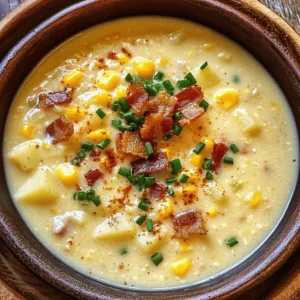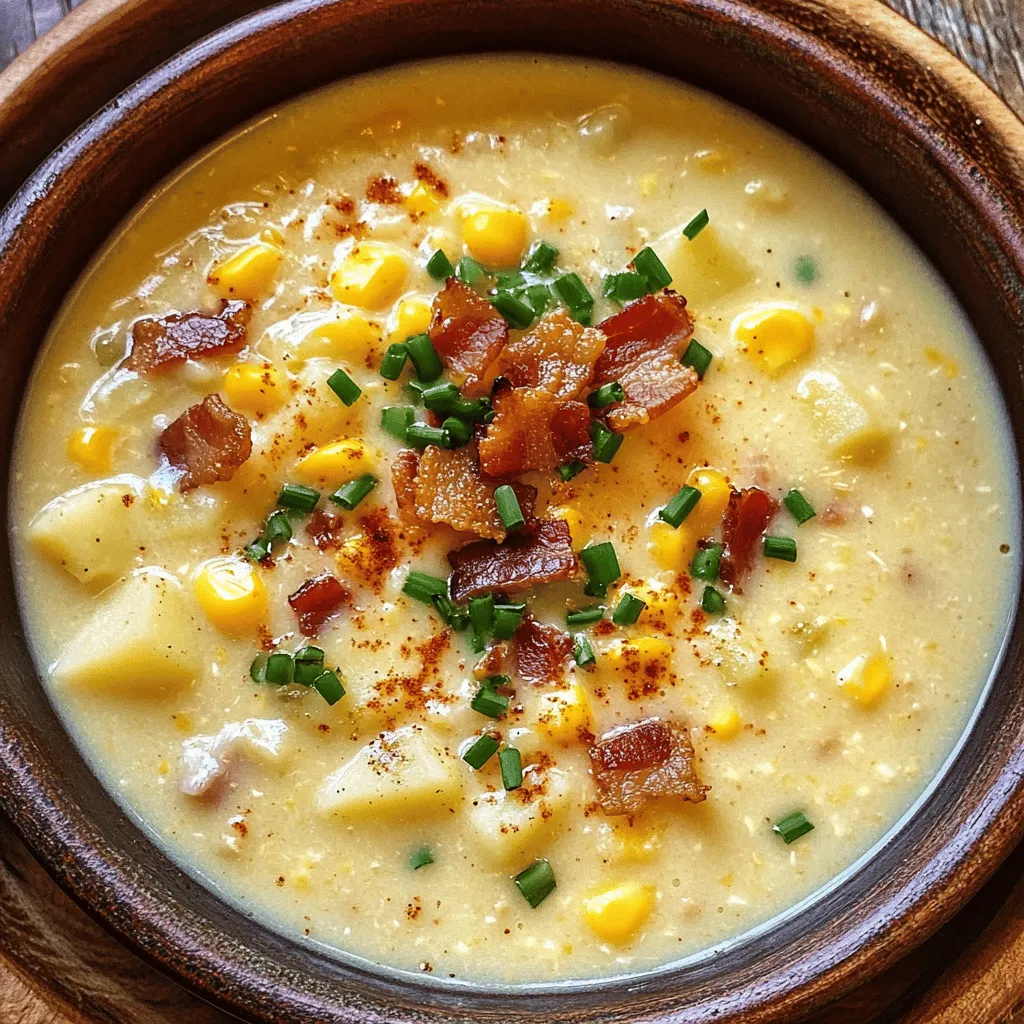Corn chowder is a beloved staple that transcends seasonal boundaries, offering a hearty and comforting experience that can warm you up during chilly winter nights or provide a refreshing meal on a warm summer afternoon. This creamy delight is not only satisfying to the palate but also a celebration of fresh ingredients, particularly sweet corn. When made with fresh corn, this chowder becomes a vibrant dish bursting with flavor and texture. In this article, we will dive into the nuances of creating the perfect Fresh Corn Chowder Delight, exploring its ingredients, preparation methods, and variations that cater to different dietary needs.
The Joy of Fresh Ingredients
Using fresh ingredients is the heart and soul of any great recipe, and corn chowder is no exception. Fresh corn, harvested at its peak, brings a sweetness and crunch that frozen corn simply cannot replicate. The joy of biting into tender kernels that pop with flavor is unmatched. Additionally, seasonal availability encourages us to visit local farmer’s markets, where we can find the freshest produce and support local agriculture.
This recipe isn’t just about following a set of instructions; it’s an opportunity to embrace the versatility of corn chowder. Whether you prefer the traditional creamy version or are looking for a dairy-free alternative, this recipe can easily adapt to your preferences. With every bowl of chowder, you can savor the rich flavors and textures that come from each carefully selected ingredient.
Understanding the Ingredients of Fresh Corn Chowder
To create a truly delightful corn chowder, understanding the key ingredients is essential. Each component plays a critical role in the overall flavor profile and texture of the dish.
Fresh Corn Kernels
The star of this dish is undoubtedly the fresh corn. Choosing fresh corn over frozen offers numerous benefits, including enhanced flavor and improved texture. Fresh corn, when harvested at the right time, boasts a natural sweetness that elevates the chowder. When selecting corn, look for ears that feel heavy for their size with tightly packed kernels and bright green husks.
In terms of seasonal availability, corn thrives in the summer months, making it the perfect ingredient for warm-weather recipes. By sourcing local produce, you not only ensure peak freshness but also contribute to your community’s economy and reduce your carbon footprint.
Bacon or Pancetta
Adding bacon or pancetta to corn chowder introduces a depth of flavor that can’t be overlooked. The savory notes from the bacon enhance the overall richness of the dish, creating a satisfying contrast to the sweetness of the corn. Cooking bacon until crisp allows the rendered fat to coat the other ingredients, infusing the chowder with its delicious essence.
For those following a dietary preference or restriction, alternatives such as pancetta or plant-based substitutes like smoked tempeh or coconut bacon can provide similar depth without compromising flavor.
Aromatics: Onion and Garlic
Onion and garlic are foundational ingredients in many savory dishes, and they play a crucial role in our corn chowder. Sautéing these aromatics at the beginning builds a robust flavor base, releasing their natural sweetness and enhancing the overall taste of the chowder. The fragrant aroma of sautéing onion and garlic is sure to entice anyone in the vicinity, setting the stage for a delicious meal.
Potatoes
Potatoes add heartiness to the chowder, providing a creamy texture that complements the corn. When choosing potatoes, Yukon Gold and Russet are both excellent options. Yukon Gold potatoes are known for their buttery flavor and creamy texture, while Russets have a fluffier consistency that breaks down beautifully in the chowder. Depending on your preference, either choice will enhance the overall texture and satisfaction of the dish.
Broth and Cream
The choice of broth is another important consideration in crafting a flavorful corn chowder. Chicken broth lends a savory richness, while vegetable broth provides a lighter, plant-based option. The broth serves as the liquid foundation of the chowder, influencing the overall taste, so choose according to your dietary preferences.
When it comes to creaminess, heavy cream adds a luxurious touch, creating a rich and silky texture. For those seeking a dairy-free option, coconut milk is an excellent alternative, imparting its own subtle sweetness and creaminess that pairs beautifully with the corn.
Herbs and Seasoning
Herbs and seasoning are essential for elevating the flavor profile of your chowder. Fresh thyme complements the sweet corn and adds a lovely herbal note. Additionally, if you enjoy a bit of heat, consider incorporating smoked paprika or cayenne pepper to enhance the chowder’s depth. These spices introduce layers of flavor that transform the chowder into a truly memorable dish.
Step-by-Step Guide to Making Fresh Corn Chowder Delight
Now that we have explored the ingredients that come together to create this delicious chowder, let’s dive into the step-by-step process of making Fresh Corn Chowder Delight. Below, we will provide clear and detailed instructions to ensure your cooking experience is enjoyable and rewarding.
Preparation of Fresh Corn
1. Boil the Corn Ears: Start by bringing a large pot of water to a boil. While waiting for the water to heat up, remove the husks and silk from the corn. Once the water is boiling, carefully add the corn ears and let them cook for about 5-7 minutes. This quick boiling helps to enhance the sweetness of the corn.
2. Cutting the Kernels: After boiling, remove the corn from the pot and let it cool slightly. Using a sharp knife, carefully cut the kernels off the cob. To do this, hold the ear of corn upright in a large bowl and slice downwards, allowing the kernels to fall into the bowl. This method minimizes mess and makes it easier to capture all the kernels.
3. Set Aside: Once you have extracted all the kernels, set them aside. This fresh corn will be the star of your chowder, providing bursts of sweetness in every bite.
Cooking the Bacon
1. Cook the Bacon: In a large stockpot or Dutch oven, add diced bacon over medium heat. Allow the bacon to cook until it becomes crispy, stirring occasionally to ensure even cooking. This process usually takes about 5-7 minutes.
2. Render the Fat: As the bacon cooks, it will render its fat, which will be crucial for flavoring the chowder. Once the bacon is crispy and golden brown, use a slotted spoon to remove it from the pot, leaving the rendered fat behind. This fat will serve as the base for sautéing your aromatics.
3. Sautéing Aromatics: In the same pot with the bacon fat, add chopped onions and minced garlic. Stir them together and let them cook for about 3-4 minutes until they are translucent and fragrant, soaking up the delicious bacon flavor.
This process sets the stage for a rich and flavorful chowder, combining the sweetness of fresh corn with the savory notes of bacon, aromatic herbs, and creamy textures.
Stay tuned for the next part of this article, where we will continue building the chowder with potatoes, broth, and finishing touches to create the ultimate bowl of Fresh Corn Chowder Delight.

Sautéing Aromatics
To begin crafting your Fresh Corn Chowder Delight, it’s essential to master the technique of sautéing the aromatics—specifically, onions and garlic. This step is crucial as it sets the flavor foundation for your chowder. Start by heating a tablespoon of olive oil or butter in a large pot over medium heat. Once the oil is shimmering, add finely chopped onions. Sauté the onions for about 5 to 7 minutes until they become translucent and slightly caramelized, stirring occasionally to prevent browning. This gentle cooking process releases the natural sugars in the onions, enhancing their sweetness.
Next, introduce minced garlic into the pot. Sauté the garlic for an additional minute, just until it becomes fragrant. Be careful not to overcook the garlic, as it can turn bitter if browned too much. The combination of these aromatics will create an enticing aroma that fills your kitchen, inviting everyone to gather around as you prepare the chowder.
Incorporating Potatoes and Broth
After achieving the perfect sauté for your onions and garlic, it’s time to add the potatoes and broth. Dice about two medium potatoes into uniform chunks, which will ensure even cooking. Add the diced potatoes to the pot, stirring gently to coat them with the sautéed aromatics. This step not only enhances the flavor but also helps the potatoes absorb the deliciousness of the sauté.
Next, pour in about 4 cups of vegetable or chicken broth, depending on your preference. This addition will provide the liquid base for your chowder. Turn up the heat to bring the mixture to a rolling boil. Once boiling, reduce the heat to low and let it simmer. Cover the pot and allow the chowder to cook for about 15 to 20 minutes, or until the potatoes are fork-tender. This gentle simmering allows the flavors to meld beautifully while ensuring the potatoes maintain their texture.
Blending for Desired Texture
A key aspect of chowder is its texture. While some enjoy a chunky chowder brimming with vegetables, others prefer a creamier consistency. At this point in the cooking process, consider whether you want to blend some of the chowder. Using an immersion blender, carefully blend a portion of the chowder until smooth. If you prefer, you can also transfer a few cups of the mixture to a traditional blender, then return it to the pot after blending. This method provides a lovely creaminess while still retaining chunks of corn and potatoes for that hearty feel.
For a more rustic approach, you can simply mash some of the potatoes with a fork or potato masher directly in the pot. This will thicken the chowder without losing the delightful pieces of corn and potatoes, allowing you to customize the chowder to your desired texture.
Finishing Touches
With your chowder blended to your liking, it’s time to add the finishing touches. Pour in about 1 cup of heavy cream or coconut milk—this will enrich the chowder, giving it a velvety texture. Stir well to combine and allow the chowder to heat through for another 5 minutes. Taste the chowder at this stage and adjust the seasoning with salt and freshly ground black pepper to enhance the flavors. You can also add fresh herbs like thyme or dill for an aromatic lift.
If you’re looking for an extra flavor boost, consider adding a splash of hot sauce or a pinch of smoked paprika to elevate the chowder further. These little touches can transform your dish into a standout meal.
Serving the Chowder
Presentation is key when serving your Fresh Corn Chowder Delight. Ladle the chowder into deep bowls and consider garnishing with a sprinkle of fresh herbs—parsley or chives work beautifully. Crumbled bacon or a sprinkle of crispy fried onions can also add texture and a savory contrast to the creamy base. For an added touch, you might drizzle a bit of olive oil or a dollop of sour cream on top.
To truly enhance the dining experience, serve your chowder alongside crusty bread or a light salad. The contrast of temperatures and textures will elevate the meal, making it not only delicious but visually appealing as well.
Nutritional Benefits of Fresh Corn Chowder
Fresh Corn Chowder is not just a comforting dish; it’s also packed with nutritional benefits, making it a wholesome addition to your diet.
Whole Food Ingredients
The primary ingredients—corn, potatoes, and fresh herbs—are all whole foods that contribute to a balanced diet. Corn is rich in fiber, vitamins B and C, and antioxidants, which can help support your immune system. Potatoes, particularly when left unpeeled, are an excellent source of potassium, vitamin C, and fiber. Fresh herbs not only enhance flavor but are also loaded with antioxidants, promoting overall health.
Protein and Healthy Fats
If you choose to add bacon or a plant-based substitute, you’ll be incorporating both protein and healthy fats into your chowder. Protein is essential for muscle repair and growth, and healthy fats contribute to satiety, ensuring that your meal is satisfying. If you opt for plant-based bacon alternatives, you can still enjoy the same protein benefits while adhering to a vegetarian or vegan diet.
Dairy-Free Adaptations
For those looking to enjoy a dairy-free version of this chowder, coconut milk is an excellent alternative. Not only does it provide a creamy texture, but it also adds a subtle sweetness that complements the corn beautifully. Coconut milk is rich in medium-chain triglycerides (MCTs), which can provide a quick energy boost, making it a nutritious substitute.
Versatility and Customization of Corn Chowder
One of the most delightful aspects of Fresh Corn Chowder is its versatility. This recipe serves as a wonderful base, allowing you to explore various adaptations to suit your taste or dietary preferences.
Vegetarian or Vegan Options
To modify the chowder for vegetarian or vegan diets, simply replace the bacon with a plant-based alternative and use vegetable broth instead of chicken broth. For creaminess, stick with coconut milk or opt for a cashew cream made by blending soaked cashews with water until smooth. This keeps the chowder indulgent while adhering to your dietary needs.
Flavor Enhancements
Feel free to experiment with additional ingredients to enhance the flavor profile of your chowder. For those who enjoy a bit of heat, consider adding diced jalapeños or a sprinkle of red pepper flakes. Sweet bell peppers can introduce a hint of sweetness, while seasonal vegetables like zucchini or carrots can boost the nutrition and color of your dish. The possibilities are endless, allowing you to tailor the chowder to your preferences.
Serving Suggestions
Pairing your Fresh Corn Chowder with complementary sides can elevate your meal. A simple crusty bread or garlic bread makes for perfect dipping accompaniments. If you prefer a lighter option, a fresh garden salad with a tangy vinaigrette balances the creamy chowder nicely. Grilled vegetables or a side of roasted corn can also add an exciting twist to your meal, creating a wholesome dining experience that feels both comforting and satisfying.
Conclusion
Making Fresh Corn Chowder Delight is not just about preparing a meal; it’s about embracing the joys of cooking with fresh, wholesome ingredients. This chowder is a celebration of flavors and textures, providing comfort and nourishment in every bowl. Its versatility allows you to customize it to fit your preferences, whether you’re looking for a vegetarian option or experimenting with different flavors.
As you embark on your cooking journey, remember that the kitchen is a canvas for creativity. Don’t hesitate to make this recipe your own, adding your favorite ingredients and flavors along the way. Enjoy the process of cooking and sharing this delightful chowder with family and friends, creating memories that revolve around good food and great company.



